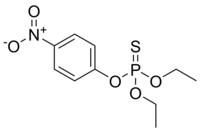
Sample preparation of chemical warfare agent simulants on a digital microfluidic (DMF) device using magnetic bead-based solid-phase extraction
Sign Up to like & getrecommendations! Published in 2017 at "Microfluidics and Nanofluidics"
DOI: 10.1007/s10404-017-1976-6
Abstract: In the present study, the purification and extraction of five chemical warfare agent (CWA) simulants, dimethyl methyl phosphonate, di(propylene glycol) methyl ether, methyl salicylate, triethyl phosphate, and diethyl phthalate, on a digital microfluidic (DMF) device… read more here.
Keywords: extraction; warfare agent; digital microfluidic; chemical warfare ... See more keywords

Ultrafast-response, highly-sensitive and recyclable colorimetric/fluorometric dual-channel chemical warfare agent probes.
Sign Up to like & getrecommendations! Published in 2021 at "Journal of hazardous materials"
DOI: 10.1016/j.jhazmat.2021.125619
Abstract: In this paper, two donor (D)-acceptor (A) type of small organic fluorescent molecules (T1 and T2) based on terpyridine group are synthesized, characterized and used as colorimetric/fluorometric dual-channel probes towards diethylchlorophosphate (DCP, the mimic of… read more here.
Keywords: dual channel; warfare agent; fluorometric dual; colorimetric fluorometric ... See more keywords

Effect of Carbon Dioxide on the Degradation of Chemical Warfare Agent Simulant in the Presence of Zr Metal Organic Framework MOF-808
Sign Up to like & getrecommendations! Published in 2019 at "Chemistry of Materials"
DOI: 10.1021/acs.chemmater.9b04565
Abstract: Developing novel and more efficient filters for chemical warfare agent (CWA) decomposition remains an important challenge for modern technology due to the continuous threat those weapons present in the event of use. Recently, metal–organic frameworks… read more here.
Keywords: warfare agent; metal organic; carbon dioxide; chemical warfare ... See more keywords

Tuning the Morphology and Activity of Electrospun Polystyrene/UiO-66-NH2 Metal-Organic Framework Composites to Enhance Chemical Warfare Agent Removal.
Sign Up to like & getrecommendations! Published in 2017 at "ACS applied materials & interfaces"
DOI: 10.1021/acsami.7b09209
Abstract: This work investigates the processing-structure-activity relationships that ultimately facilitate the enhanced performance of UiO-66-NH2 metal-organic frameworks (MOFs) in electrospun polystyrene (PS) fibers for chemical warfare agent detoxification. Key electrospinning processing parameters including solvent type (dimethylformamide… read more here.
Keywords: uio nh2; nh2 metal; chemical warfare; warfare agent ... See more keywords

Destruction of chemical warfare agent simulants by air and moisture stable metal NHC complexes.
Sign Up to like & getrecommendations! Published in 2018 at "Dalton transactions"
DOI: 10.1039/c7dt04805j
Abstract: The cooperative effect of both NHC and metal centre has been found to destroy chemical warfare agent (CWA) simulants. Choice of both the metal and NHC is key to these transformations as simple, monodentate N-heterocyclic… read more here.
Keywords: metal nhc; warfare agent; metal; chemical warfare ... See more keywords

Experimental and computational study of the inclusion complexes of β-cyclodextrin with the chemical warfare agent soman (GD) and commonly used simulants
Sign Up to like & getrecommendations! Published in 2017 at "RSC Advances"
DOI: 10.1039/c7ra03328a
Abstract: The hydrophobically driven inclusion complexation of the Chemical Warfare Agent (CWA) pinacolyl methylphosphonofluoridate (soman, or GD) by β-cyclodextrin (β-CD) is studied both experimentally and computationally. Semiempirical modelling (PM6) adds further insight to the understanding of… read more here.
Keywords: agent; inclusion; commonly used; warfare agent ... See more keywords

A novel approach to interrogating the effects of chemical warfare agent exposure using organ-on-a-chip technology and multiomic analysis
Sign Up to like & getrecommendations! Published in 2023 at "PLOS ONE"
DOI: 10.1371/journal.pone.0280883
Abstract: Organ-on-a-chip platforms are utilized in global bioanalytical and toxicological studies as a way to reduce materials and increase throughput as compared to in vivo based experiments. These platforms bridge the infrastructure and regulatory gaps between… read more here.
Keywords: chemical warfare; chip; warfare agent; organ chip ... See more keywords